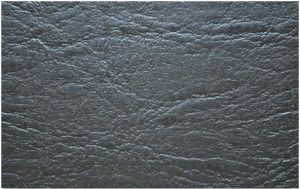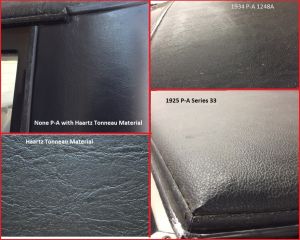- Home
- About Us
- Join/Renew
- Member Benefits
- Member Pages
- Log In
- Help
- Museum Store
See are about ready to put a new top on my Son in laws 26 series. 80 sedan . What material should we use long grain or short? The loathing is new oak and looks great. Also I am thinking we need padding. Where is the best place to get the top material , it should be 8 ft X 65″ thanks Doug Vogel
“
Doug,
Wait until David Coco gets back home from the meet. He does exquisite upholstery work, and can give you all the information you need.
I agree, Dave is the go to guy on this question……..
Thanks guys, My kindle fire keeps changing my spelling, and my eyesight on this little thing isn’t that great.
Jim Hycner in Silver Spring Ny just replaced the top on his ’26 Series 80 2door coach. He had some difficulty finding wide enough material. I think he said only one source had it wide enough.
I’d send Jim a message through the forum, and ask his advice as well as David Coco.
Greg Long
Just back from the Gathering so catching up. We looked at a couple of original tops that were at the meet, and I’ve looked at a number of original tops over the years. However, this is my opinion, as it’s been discussed before and there are other opinions.
What I’m seeing is not a heavy grain. It almost appears to be a multidirectional grain, and is very light, as if you took a short grain material (like a cobra grain) and sanded it down.
So, that doesn’t really answer the question “what should I use”. One option is what is called Colonial Grain, available from Lebaron Bonney and probably others.
My advice would be to get samples of different topping materials, and pick the one with the lightest grain, and use that.
As a side note, a trimmer never likes to see oak in a car, particularly when using tacks. Oak is a hard wood, but has a very large and loose grain, and splits easily when driving a tack into it. Not meant as criticism, just as information….
Thanks so much David and Greg. Also what kind of padding should I use , I’ve been told the padding used in Quilts is the way to go .
Doug,
Just to add a bit of angst to the conversation, remember that the only part of the top material that anyone will ever see without being on a serious stepladder is the two-to-three-inche span that show at the edge of the top where it rolls over to the drip edge.
Other than my dumb comment, my Series 80, 7-Passenger DeLuxe was painted in 1990 and the top material was replaced.
The material they used has a pronounced grain.
Access to top materials was limited at that time, relative to today, and maybe it was more correct because of the times. Who knows?
Long or short, I DK on that matter, but I will send you a photo if you desire.
Also, as any P-A enclosed car knows, cleaning the top requires a 10-foot step-ladder to access the center, likewise, seeing the top except from a second story window.
On another aspect of your initial comment, the top is indeed padded.
There is a lattice (not loathing) nearest to the interior to which the headliner is mysteriously attached (no exposed tacks).
On top of that is some type of thick padding and then (perhaps) some chicken-wire type of material with more padding before the top material covers everything.
This is my observation on the top construction and I am confident that others more familiar with the matter will chime in.
Have fun with the restoration and post photos of the process.
Peter
David,
I believe the top material on my Series 80 may be original or close to it if you would like a snap shot of it or to examine you are always welcome to stop by. I would describe it as you have above about the multidirectional, light grain.
James
The proper construction of the top insert should be, in my experience and observation:
-wooden slat framework
-chicken wire
-very thin material over chicken wire, similar to drapery backing cotton material
-very thin cotton batting, yes, you can go to a fabric store and get quilt padding, it’s very thin, I usually use two layers
-top material
Please don’t use foam, it will disintegrate. Also, the chicken wire is often used as the antenna for the radio in later cars. As such, it is attached to the wood only, and not touching any metal body part.
Headliners have a seam sewed in them, and the seam will leave a tail of about half an inch. To this tail is sewed a piece of listing (thin cotton fabric). The listing is tacked to the cross braces of the top, starting in the middle and stretching to the side as you go, hanging the headliner slightly below the cross braces. The other old trimmer trick is to use tacks on the listing, and DON’T drive them all the way in. That way you can pull sideways on the headliner to eliminate wrinkles, and the listing will rotate on the tack allowing you to do so.
Doug-I replaced the top on my Series 80 last winter. We do believe it was the original since there were no extra tack holes in the wood. If it was replaced there would have been many extras tack marks. The roof was made up with the top, 1/8″ jute backing (only on the very top, it did not extend down the sides). Under the jute was a burlap that was tacked in place. Attached is a picture of the ash slats that are underneath. The was NO chicken wire. I do believe that was only used on the later Pierces.’29 & up. The only place I found material wide enough was Lebaron Bonney. My top did not have any seams nor did i ever see them on a few other unrestored Series 80’s The grain is a more pronounced than my original fabric, but the closest I found. They have 4 or 5 different grains available. Just ask for samples. I ordered the burlap from them as well. I could not find the original style jute so I used a white polyester fabric they had fro a Ford Model A. PM if you want more pictures or details. Mine came out great-not that hard if you take a little time.
Hi Jim, your car’s top construction is interesting. It appears that extra wood slats were used instead of the normal chicken wire over wider-spaced slats.
The Series 80 top construction I’ve seen has had slats spaced about 6″ to 8″ apart with the chicken wire stretched over them to support the padding.
Your top looks like it was intended to support more weight or maybe there was a shortage of chicken wire at the time of construction? I certainly don’t know, but your heavy-duty top construction is unique in my experience.
Greg Long
I agree, I’ve put a number of top inserts in a lot of different make cars, and never seen such a robust top frame. Much more typical, as Greg mentions, to have the larger spacing for the front to back slats.
As to the jute, you can buy it in different weights. The most common available now are 20 ounce (about 1/4 inch thick) and 40 ounce (about 1/2 inch thick). The weight is per square yard of the jute fabric. If I were using jute on an insert top, I’d go with the 20 ounce. You don’t want such a thick padding that the top material stands “proud”” of the roofline.”
Hi All,
Doug, I had a similar issue with trying to find a nearly none existent (or light) grain for the top of a car like a Series 80. The issue I was finding was everything had a pronounced grain (long or short cobra grain) which was common on Ford and Dodge cars. If I looked at original tops of other cars of the ’20s, including Pierce-Arrow, I did not see a pronounced liner grain.
After calling around and talking to a lot of people in many clubs it was determined that I call Eric Haartz. Being young and naive I called the company front desk, told them who I was, and asked to speak with Eric. He was nice enough to take my call and gave a suggestion that became my solution.
His recommendation was to use a Tonneau material which has a very light grain. This material is 78″ to 84″ wide, weatherproof, and pliable enough to make corners easily. Luckily for a Series 80 you do not have to cover/pad the back window area. The grain (pictured below) shows a criss cross grain that is light and not liner. This has been a nearly perfect application for the car and does not distract from what the vehicle would of had originally.
This is what worked for me. I know that everyone’s experience is different but overall I could not be happier with the outcome. 7 years later the top still looks good while not distracting from the original look of the car

Eric Haartz is a great resource for our hobby, I won’t go into the whole story, but he reproduced 40 yards of a fantastic replicated Pantasote for me, which now is proudly on two 1907 Autocars, a 1909 Reo, and a 1910 Stanley….and it’s great, black with a whipcord liner, impossible to get these days. Oh, and I have enough material left to do one more of my cars! He should be commended for his efforts, which are motivated by his love of early cars. Stop at Hershey on the Red Field and say hi to him! I do think that the Tonneau material that Benjamin is referencing is one of the closest things to original I’ve seen, a good grain, but no distinct directional stamping….thanks for sharing…
This picture shows a comparison to the Tonneau material from Haartz versus original tops of this era.
Note: I am sure there are other suppliers that have a similar grain for a tonneau cover in your area. This is just to show comparison of one brand to what would be original.

Thanks for the pictures Ben . It looks like we need to use the same smooth grain as I put on my 1933 1247. I put it on 8 years ago and it still looks great. The long and short grains now look totally wrong. Thanks to you all! I ordered samples from lebaron bonney. So we will see what comes. Will try others as well. Doug
Doug,
If you haven’t already done so, check out the Message Board Discussion started by Steve Pugh regarding the correct top insert material for his ’37 Coupe.
Thank e Joe, that helps. I never would have found that.
Folks,
For those of you looking for a closer approximation of the top insert material for Pierce-Arrows of the 30s and, it would appear, of the 20s, allow me to inform you that I had a conversation with Eric Haartz of The Haartz Corporation this past week ((9/18/17). I have had this conversation with Eric before and he appreciates the lack of choices currently available in terms of both pattern and sheen. It would appear that we may expect a good replication of the material we want for our vehicles in the upcoming (2018) year.
For those of you new to this worthwhile pursuit of authenticity, I refer you to a discussion initiated by Steve Pugh on the Message Board regarding the correct top insert material for his ’37 Coupe.
Eric’s telephone number, should you wish to encourage him in his efforts, is: (978)264-2600.
Joe Malone
